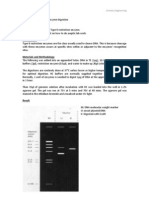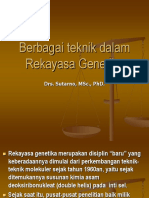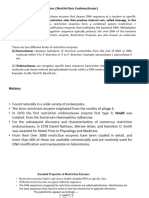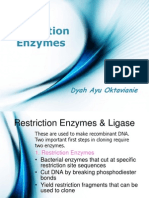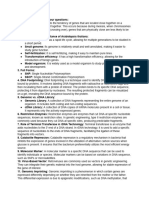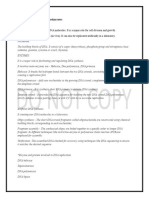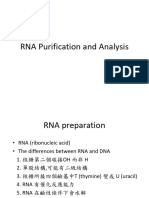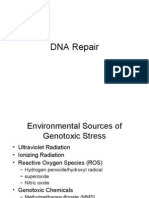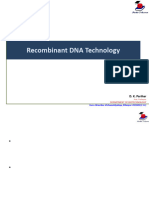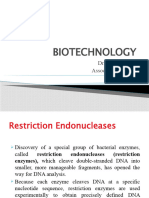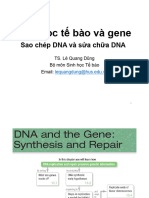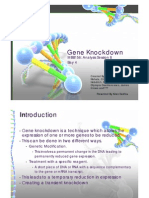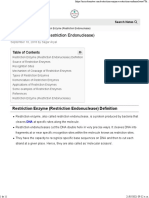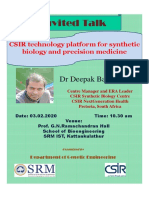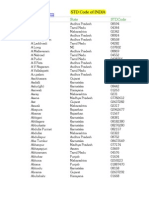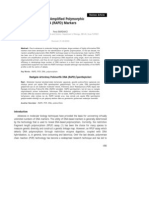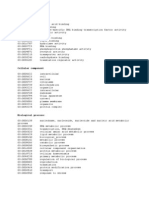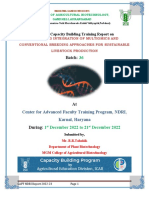ZFN
ZFN
Uploaded by
Senthilkumar PalanisamyCopyright:
Available Formats
ZFN
ZFN
Uploaded by
Senthilkumar PalanisamyCopyright
Available Formats
Share this document
Did you find this document useful?
Is this content inappropriate?
Copyright:
Available Formats
ZFN
ZFN
Uploaded by
Senthilkumar PalanisamyCopyright:
Available Formats
Genome editing
Genome editing,
or genome editing with
engineered
nucleases (GEEN) is a
type of genetic
engineering in
which DNA is inserted,
replaced, or removed from
a genome using artificially
engineered nucleases, or
"molecular scissors."
Mechanism
The nucleases create specific double-
stranded break (DSBs) at desired locations in
the genome, and harness the cells
endogenous mechanisms to repair the
induced break by natural processes of :
homologous recombination (HR)
nonhomologous end-joining (NHEJ).
So based on these principles if one is able
to create a DSB at a specific location
within the genome, then the cells own
repair systems will help in creating the
desired mutations.
Site-specific double stranded
breaks
if genomic DNA is treated with a particular
restriction endonuclease many DSBs will be
created.
To overcome this challenge and create site-
specific DSB, three distinct classes of nucleases
have been discovered and bioengineered to
date:
Zinc finger nucleases (ZFNs),
Transcription-Activator like Effector Nucleases
(TALENs)
Meganucleases
Meganucleases
Meganucleases, found commonly in microbial
species, have the unique property of having very
long recognition sequences (>14bp) thus making
them naturally very specific.
But the challenge is that: not enough
meganucleases are known, or may ever be
known, to cover all possible target sequences.
Mutagenesis and high throughput screening
methods have been used to create
meganuclease variants that recognize unique
sequences.
Meganuclease
advantages and disadvantages.
very specific
the construction of sequence specific
enzymes for all possible sequences is
costly and time consuming.
As opposed to meganucleases, the concept
behind ZFNs and TALENs is more based on a
non-specific DNA cutting enzyme which would
then be linked to specific DNA sequence
recognizing peptides such as:
zinc fingers and
transcription activator-like effectors (TALEs)
The key to this was to find an endonuclease
whose DNA recognition site and cleaving
site were separate from each other, a
situation that is not common among
restriction enzymes.
A restriction enzyme with such properties
is FokI.
Zinc-Finger Nucleases
What is a Zinc Finger ?
In eukaryotes, often complex sets of
regulatory
elements control the initiation of
transcription
of genes. Upstream of the RNA
polymerase II initiation site there are
different
combinations of specific DNA sequences,
each of
which is recognized by a corresponding
site-specific DNA-binding protein. These
protein
are called transcription factor.
Transcription factors have two functionally
different domains, one that binds to specific
DNA
sequences and another that activates
transcription. And now NMR methods recently
have
been used to determine the 3D structure of
these
motifs zinc fingers, leucine zippers, and
helix-turn-helix motifs.
The zinc finger motif was first
described in 1985 in the laboratory of Aaron
Klug
at the MRC laboratory of Molecular Biology in
Cambridge, where it was inferred from an
analysis
of the amino acid sequence of the transcription
factor TFIIIA from Xenopus laevis.
Zinc finger domains
Large superfamily of protein domains
Characterised by 2 anti parallel b sheets and 1 a helix
Structure stabilised by binding of Zinc ion
Zinc binding mediated by specific cysteine (b sheets) and histidine
(a helix) residues
N terminal
C terminal
Zn
Role of zinc finger domains
Zinc finger domains make multiple contacts on target
molecule
Can bind to DNA, RNA, protein and/or lipids
Binding properties depend on specific type of zinc finger,
no of fingers and sequences therein
Versatility in binding results in specialised functions
including gene transcription, translation, mRNA
trafficking, cytoskeletal organisation and chromatin
remodelling.
Over 70 different classes of zinc finger domains
recognised
The structure of the zinc finger motif is formed by
coordination of the zinc(II) ion.
Zinc-Finger Nucleases have two domains
1. DNA-binding Domain
2. DNA-cleavage Domain
Chandrasegaran proved that cutting could be redirected by
substituting alternative recognition domain.
Three fingers of a ZF bound to DNA showed that each finger
contacts 3 bp of DNA in a remarkable fashion.
This suggest many different sequences can be attacked by
making novel assemblies of ZFs.
FokI enzyme
The enzyme FokI, naturally found
in Flavobacterium okeanokoites, is a bacterial type
IISrestriction endonuclease consisting of:
FokI restriction endonuclease recognizes the non-palindromic
penta-deoxyribonucleotide 5-GGATG-3:5-CATCC-3 in
duplex DNA and cleaves 9/13 nucleotides downstream of the
recognition site.
Synthetic derived from Fok I a Type II Restriction enzyme
which has physically separable binding and cleavage
activities.
an N-terminal DNA-binding domain and
a non-specific DNA cleavage domain at the C-terminal.
FokI dimerization
FokI has the advantage of requiring
dimerization to have nuclease activity and
this means the specificity increases
dramatically as each nuclease partner would
recognize a unique DNA sequence.
Mre11/Rad50/Nbs1 complex
Strand invasive protein Rad 51
DNA Polymerase
DNA Ligase
Chromosomal breaks are detected in cells as
potentially lethal damage, and one natural
pathway of DSB repair is copying from a
homologous template.
From this perspective, DSB-stimulated gene
targeting simply provides an exogenous template
for a natural repair process.
An alternative repair pathway for DSBs,
nonhomologous end joining, often joins the
broken ends inaccurately, creating deletions,
insertions, and substitutions at the break site.
You might also like
- MBY 364 NOTES - MergedDocument22 pagesMBY 364 NOTES - Mergedroelienvv7No ratings yet
- Restriction Enzyme DigestionDocument3 pagesRestriction Enzyme DigestionMahathir Mohmed100% (1)
- IGNTU EContent 315483864108 M.SC EnvironmentalScience 2 ManojkumarRai Environmentalmicrobiologyandbiotechnology 3Document66 pagesIGNTU EContent 315483864108 M.SC EnvironmentalScience 2 ManojkumarRai Environmentalmicrobiologyandbiotechnology 3subhasis124p13No ratings yet
- Engenharia GenéticaDocument34 pagesEngenharia GenéticaPatricia LopesNo ratings yet
- Aula BMol 2Document35 pagesAula BMol 2Diogo MadalenoNo ratings yet
- Chapter 9Document70 pagesChapter 9علوم طبية AUG 2020No ratings yet
- Mod2 PDFDocument30 pagesMod2 PDFمحمود عامرNo ratings yet
- Restriction EnzymesDocument16 pagesRestriction EnzymesSatyam AryaNo ratings yet
- Lecture 4 Tools in Molecular BioloyDocument24 pagesLecture 4 Tools in Molecular BioloyAksh TiwariNo ratings yet
- Introduction To Gene Cloning and Genetic Engineering: Tools of Recombinant DNA TechnologyDocument70 pagesIntroduction To Gene Cloning and Genetic Engineering: Tools of Recombinant DNA Technologykaira.raina.ghoshNo ratings yet
- Bio II - Lab 7 Restriction Enzymes Gel ElectrophoresisDocument11 pagesBio II - Lab 7 Restriction Enzymes Gel Electrophoresisariannecool2002No ratings yet
- Berbagai Teknik Dalam Rekayasa Genetika: Drs. Sutarno, MSC., PHDDocument22 pagesBerbagai Teknik Dalam Rekayasa Genetika: Drs. Sutarno, MSC., PHDNabilaNo ratings yet
- R DNA TchnologyDocument32 pagesR DNA TchnologyReena GuptaNo ratings yet
- Smith Et Al 2000 ZFN - 124353Document9 pagesSmith Et Al 2000 ZFN - 124353romaodiamantino37No ratings yet
- Restriction Enzymes: Biochemistry Seminar Fathima I Nazeer February 13 2004Document17 pagesRestriction Enzymes: Biochemistry Seminar Fathima I Nazeer February 13 2004Ashima GoelNo ratings yet
- II ME NRP B SS 27. Biotechnology-Principles and Processes, Biotechnology - ApplicationsDocument8 pagesII ME NRP B SS 27. Biotechnology-Principles and Processes, Biotechnology - ApplicationsAmit RavindhraNo ratings yet
- Lecture 10 Restriction EnzymesDocument9 pagesLecture 10 Restriction Enzymesmenevolution70No ratings yet
- Restriction EnzymesDocument14 pagesRestriction EnzymesAman UllahNo ratings yet
- 2.basic Tools-Restriction EnzymesDocument51 pages2.basic Tools-Restriction Enzymesshruti shahNo ratings yet
- Restriction EnzymeDocument33 pagesRestriction EnzymeFawaz Mohamad100% (1)
- UNIT - II (Part-I)Document16 pagesUNIT - II (Part-I)Aman KhanNo ratings yet
- Recombinant DNA TechnologyDocument26 pagesRecombinant DNA TechnologyManikandan VpNo ratings yet
- Enzymes Used in RDT Corrected Version EditedDocument43 pagesEnzymes Used in RDT Corrected Version EditedYuppie RajNo ratings yet
- Biotechnology - Principle ProcessDocument9 pagesBiotechnology - Principle Processtamalbio7No ratings yet
- Useful To Human. Analogues For Products and Services: BIOTECHNOLOGY - Principles and ProcessesDocument10 pagesUseful To Human. Analogues For Products and Services: BIOTECHNOLOGY - Principles and ProcessesKorou LaikhaNo ratings yet
- Lecture 20.recombinant DNA TechnologyDocument99 pagesLecture 20.recombinant DNA Technologyqanitakhan2002No ratings yet
- Restrictionenzymes-1Document26 pagesRestrictionenzymes-1Aleena MustafaNo ratings yet
- TY - Biotech - Restriction EndonuceaseDocument40 pagesTY - Biotech - Restriction Endonuceasebibekanandapradhan5249No ratings yet
- Contents:: Project Report 1. Introduction To Recombinant DNA TechnologyDocument15 pagesContents:: Project Report 1. Introduction To Recombinant DNA TechnologyShivraj GundayyaNo ratings yet
- Restriction EnzymeDocument15 pagesRestriction EnzymeBhuyashi BaidyaNo ratings yet
- Restriction Enzymes: Dyah Ayu OktavianieDocument20 pagesRestriction Enzymes: Dyah Ayu OktavianieFarel Isbister Stewart GurningNo ratings yet
- Note 1492433946Document23 pagesNote 1492433946Priyanshi choudharyNo ratings yet
- Techniques of Molec Ular BiologyDocument59 pagesTechniques of Molec Ular Biologyelmusy alpussyNo ratings yet
- Tools of Recombinant Dna TechnologyDocument3 pagesTools of Recombinant Dna Technologyamora eliNo ratings yet
- Nucleic AcidsDocument37 pagesNucleic AcidsValine Cysteine MethionineNo ratings yet
- Molecular Biology Short Questions GU Sem 5Document2 pagesMolecular Biology Short Questions GU Sem 5AnupamNo ratings yet
- UNIT 1 Genetic EngineeringDocument60 pagesUNIT 1 Genetic Engineeringshruti.15.panditNo ratings yet
- Mekanisme Replikasi, Repair DNA Dan Rekombinan DNADocument50 pagesMekanisme Replikasi, Repair DNA Dan Rekombinan DNAnolaNo ratings yet
- The Replication of DNA in ProkaryotesDocument6 pagesThe Replication of DNA in ProkaryotesAditya KukretiNo ratings yet
- Nucleic Acid BiotechnologyDocument48 pagesNucleic Acid Biotechnologymonzon.mika1801No ratings yet
- Lecture 2 - Chap 13 Production of Protein From Bacterial Cloned GenesDocument37 pagesLecture 2 - Chap 13 Production of Protein From Bacterial Cloned Geneslinkason53jpNo ratings yet
- HahahahDocument4 pagesHahahahkizzaymenteraNo ratings yet
- Zinc Finger NucleaseDocument11 pagesZinc Finger NucleaseDavid Maycotte-CervantesNo ratings yet
- 11 03 2006 MCB Repair 1Document80 pages11 03 2006 MCB Repair 1api-3696530No ratings yet
- Chapter 5 MboiDocument82 pagesChapter 5 MboiFEAR GAMING FFNo ratings yet
- RDT Hostcontrolled Restriction and ModificationDocument59 pagesRDT Hostcontrolled Restriction and ModificationAshutoshNo ratings yet
- I Recombinant DNA TechnologyDocument37 pagesI Recombinant DNA TechnologyGundeep BrarNo ratings yet
- Biotech Lab I BT311 Part 1Document39 pagesBiotech Lab I BT311 Part 1mennaosama011No ratings yet
- MB 2Document76 pagesMB 2ahkrabNo ratings yet
- Mira Molecular Biology Part1Document63 pagesMira Molecular Biology Part1Ranim MiraNo ratings yet
- Abt001 Restriction Enzymes FinalDocument11 pagesAbt001 Restriction Enzymes FinalLaureen ElleNo ratings yet
- BIOTECHNOLOGYDocument9 pagesBIOTECHNOLOGYtamalbio7No ratings yet
- BiotechnologyDocument36 pagesBiotechnologyFarwa JawadNo ratings yet
- Sao Chép DNA Và S A CH A DNADocument32 pagesSao Chép DNA Và S A CH A DNAtrinhthungoct66No ratings yet
- DNA Replication, Repair, and RecombinationDocument92 pagesDNA Replication, Repair, and RecombinationJagdesh SajnaniNo ratings yet
- Gene Knockdown: MBB156: Analysis Session 8 Bay 4Document11 pagesGene Knockdown: MBB156: Analysis Session 8 Bay 4kirandedhiaNo ratings yet
- Restriction Enzyme (Restriction Endonuclease)Document11 pagesRestriction Enzyme (Restriction Endonuclease)JocesesNo ratings yet
- Genetic EngineeringDocument38 pagesGenetic EngineeringNaila Izzaty KarimahNo ratings yet
- Plant Growth and Development-An IntroductionDocument6 pagesPlant Growth and Development-An IntroductionSenthilkumar PalanisamyNo ratings yet
- Pre-Incubation & Incubation Management PDFDocument2 pagesPre-Incubation & Incubation Management PDFSenthilkumar PalanisamyNo ratings yet
- DR - Deepak Balaji TG Invited TalkDocument1 pageDR - Deepak Balaji TG Invited TalkSenthilkumar PalanisamyNo ratings yet
- Conference BrochureDocument2 pagesConference BrochureSenthilkumar PalanisamyNo ratings yet
- MCQ On Cytology - Cell and Cell Organelles MCQ Biology - Learning Biology Through MCQsDocument5 pagesMCQ On Cytology - Cell and Cell Organelles MCQ Biology - Learning Biology Through MCQsSenthilkumar Palanisamy100% (2)
- STD Code of IndiaDocument440 pagesSTD Code of Indiayuvibt5491No ratings yet
- ImmunologyDocument1 pageImmunologySenthilkumar PalanisamyNo ratings yet
- Aucr2004 PDFDocument37 pagesAucr2004 PDFSenthilkumar PalanisamyNo ratings yet
- CharanDocument1 pageCharanSenthilkumar PalanisamyNo ratings yet
- Krishidhan Molecular BreedingDocument2 pagesKrishidhan Molecular BreedingSenthilkumar PalanisamyNo ratings yet
- A Potent Antifungal Protein From Helianthus Annuus Flowers Is A Trypsin InhibitorDocument8 pagesA Potent Antifungal Protein From Helianthus Annuus Flowers Is A Trypsin InhibitorSenthilkumar PalanisamyNo ratings yet
- (P) Random Amplified PolymorphicDNA (RAPD) Markers PDFDocument12 pages(P) Random Amplified PolymorphicDNA (RAPD) Markers PDFDewi Kartika DekaNo ratings yet
- GO TermDocument2 pagesGO TermSenthilkumar PalanisamyNo ratings yet
- How To Isolate Proteins FinalDocument9 pagesHow To Isolate Proteins Finalmukeshsriwastva14No ratings yet
- ZFNDocument20 pagesZFNSenthilkumar PalanisamyNo ratings yet
- Notes DNA ComputingDocument26 pagesNotes DNA ComputingShaheerNo ratings yet
- Restriction Enzymes PDFDocument7 pagesRestriction Enzymes PDFmanoj_rkl_07No ratings yet
- Caft ReportDocument26 pagesCaft Reportrushi tahakikNo ratings yet

